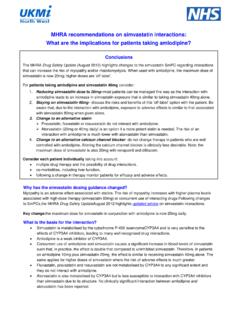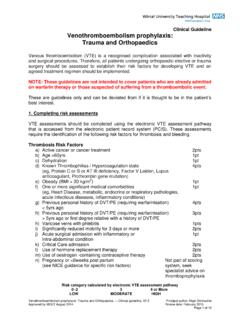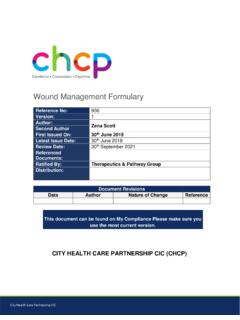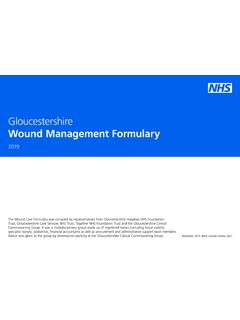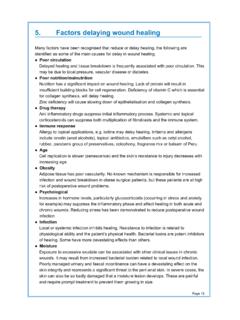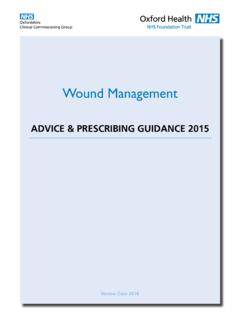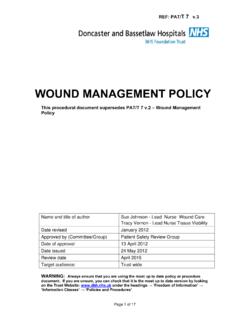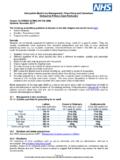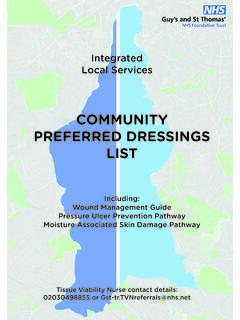Transcription of Wound dressings - Wirral Medicines Management
1 Wound dressings guidance for use - Clinical Guideline, v2 Page 1 of 10 Authors: Bill Haughton, Chris Herring Approved by Wirral Wide formulary Group: June 2013 Review by: August 2014 Wirral University Teaching HospitalNHS Foundation TrustClinical guideline Wound dressings Guidance for Use There are several types of dressings in use at Wirral University Teaching Hospitals NHS Foundation Trust (WUTH). These are: 1. Interactive dressings a) Hydrocolloid dressings (i)DuoDERM, Duoderm Extra Thin & Duoderm Extra dressing Adhesive, occlusive hydrocolloid dressing with a vapour-permeable outer film layer. Forms a gel on contact with exudate.
2 DuoDERM extra thin is transparent. All are waterproof. Indications. Lightly to moderately exuding necrotic, sloughy or granulating wounds, including pressure ulcers, leg ulcers, diabetic foot ulcers, surgical wounds, partial thickness burns, and abrasions. Cautions. Do not use in the presence of Wound infection unless an appropriate systemic antibiotic is given concurrently. Not appropriate for use on cavity wounds in the absence of a cavity filler. Dressing change. As the dressing absorbs exudate, a yellowish gel is formed. For the Signal dressing, when the gel reaches the green indicator line, the dressing should be changed. Maximum wear time 7 days.
3 Any gelled dressing material left on the Wound can be irrigated away using warmed sodium chloride solution or warmed tap water. When applying the dressing, a 3cm overlap of the Wound margin is needed to ensure a seal. Removal. Press down gently on the skin and carefully lift one corner of the dressing, stretching each edge until free. Avoid applying traction to the Wound or surrounding skin. (ii) Comfeel Plus, Ulcer, Transparent & Contour dressing An adhesive, absorbent dressing containing sodium carboxymethylcellulose, which forms a gel on contact with Wound exudate; and alginate, which assists in the absorption of exudate Indications. Comfeel Plus Ulcer and Contour dressings are used on low to moderately exuding, necrotic, sloughy or granulating open wounds, including pressure ulcers and leg ulcers.
4 Contour dressing is designed for use on difficult-to-dress areas heels and elbows. Comfeel Transparent dressing is used on superficial burns, and superficial open wounds including category 2 pressure ulcers, donor sites, postoperative wounds and abrasions. Cautions. Do not use in the presence of Wound infection, unless an appropriate systemic antibiotic is given concurrently. Not appropriate for use on cavity wounds in the absence of a cavity filler. dressings must be removed prior to radiation treatment (X-rays, ultrasonic treatment, diathermy and microwaves). Dressing change. When Comfeel Plus dressings absorb exudate, a whitish gel is formed.
5 When the gel reaches the outer film layer, the dressing will appear "marbled" or transparent. Change the dressing when it becomes transparent. Any gel remaining on the Wound surface can be irrigated away using warmed sodium chloride solution or warmed tap water. When applying the dressing, a 2cm overlap of the Wound margin is needed to ensure a seal. Wound dressings guidance for use - Clinical Guideline, v2 Page 2 of 10 Authors: Bill Haughton, Chris Herring Approved by Wirral Wide formulary Group: June 2013 Review by: August 2014 Wirral University Teaching HospitalNHS Foundation TrustRemoval.
6 Avoid applying traction to the Wound or surrounding skin, roll from one corner or edge to remove gently. b) Hydrogel dressings Aquaform is a clear, viscous sterile gel containing a modified starch polymer, glycerol, preservatives and water. Indications. Necrotic or sloughy wounds. Facilitates autolysis by rehydrating eschar and slough. (but see manuka honey dressings ) Cautions. Sensitivity to the gel or its components. Inappropriate for use on heavily exuding wounds. If Wound infection develops during treatment, appropriate antimicrobial therapy should be initiated. Treatment with a hydrogel dressing may be continued. Dressing change.
7 Change every 1 to 3 days, depending on the amount of exudate or liquefied eschar. Requires a secondary dressing - a semi-permeable film dressing may be appropriate. Do not use a hydrocolloid product (Comfeel range, DuoDERM range) as a secondary dressing, as these products are unable to manage the increased fluid levels produced by hydrogels. Removal. Remove gel by irrigation with warmed sodium chloride solution, or warmed tap water. c) Alginate dressings (i) Kaltostat ( secondary Care Use) Kaltostat is an 80% calcium alginate/20% sodium alginate dressing. It is an absorbent, haemostatic dressing, which forms a viscous gel on contact with Wound exudate.
8 Requires a secondary dressing - a semi-permeable film dressing ( C-View) may be appropriate. Indications. Bleeding wounds - all presentations are haemostatic. All types of exuding Wound . Do not moisten prior to use, as this defeats its function as an absorbent dressing. Cautions. Do not use on dry wounds. Reserve for use where haemostasis is required postoperatively. Dressing change. Change as dictated by the amount of exudate. Maximum wear time is 7 days. Removal. Kaltostat maintains its integrity when gelled, allowing one-piece removal. If adherence occurs, assist removal by gently irrigating with warmed sodium chloride solution.
9 (ii)Sorbsan (primary Care use) Sorbsan is a sterile, non-woven calcium alginate dressing. It is an absorbent, haemostatic dressing which forms a viscous gel on contact with Wound exudate. Requires a secondary dressing - a semi-permeable film dressing ( C-View) may be appropriate. Indications as for Kaltostat. Due to the dissolvable nature of Sorbsan, it may be a more appropriate option than Kaltostat for narrow, deep wounds where removal of a plug is problematic see Removal below. Cautions as for Kaltostat. Dressing change as for Kaltostat. Wound dressings guidance for use - Clinical Guideline, v2 Page 3 of 10 Authors: Bill Haughton, Chris Herring Approved by Wirral Wide formulary Group: June 2013 Review by: August 2014 Wirral University Teaching HospitalNHS Foundation TrustRemoval.
10 The gel can be removed from the Wound by gentle irrigation with sodium chloride solution ( ). This will dissolve the viscous plug and allow complete removal. d) Fibrous absorbent dressings (i)Aquacel Extra dressings An absorbent Hydrofiber dressing consisting of sodium carboxymethylcellulose, which forms a gel on contact with Wound exudate. The dressing absorbs exudate vertically, avoiding lateral wicking, and therefore reducing the risk of peri- Wound maceration. Requires a secondary dressing - a semi-permeable film dressing ( C-View) or a thin hydrocolloid dressing ( Comfeel Plus Transparent) may be appropriate.





